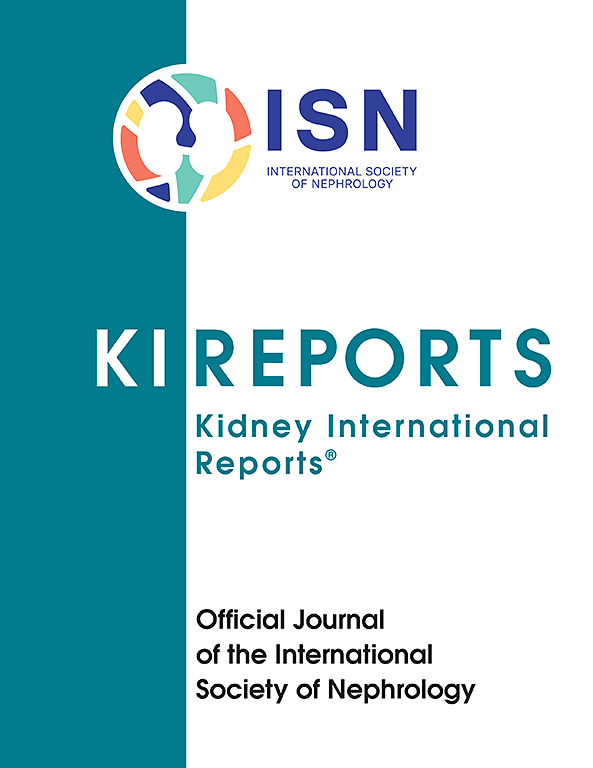Clinical Presentation and Outcomes of Antineutrophil Cytoplasmic Autoantibody–Negative Pauci-Immune Glomerulonephritis
IF 5.7
2区 医学
Q1 UROLOGY & NEPHROLOGY
引用次数: 0
Abstract
Introduction
Antineutrophil cytoplasmic autoantibody (ANCA)-associated vasculitis is a rare, complex autoimmune condition. Although ANCAs have a pathogenic role, they are considered a suboptimal biomarker of disease activity. Previous studies suggest differences in clinical phenotypes and outcomes in those without detectable circulating autoantibody. This study aimed to investigate the clinical presentation, histopathological findings, treatment practices, and outcomes of patients with ANCA-negative pauci-immune glomerulonephritis (PIGN).
Methods
A retrospective, multicenter cohort study was conducted from 2002 to 2022 and included those with biopsy-proven PIGN. We aimed to investigate differences in presentation, clinical outcomes, and treatment practices of patients with ANCA-negative PIGN when compared with ANCA-positive controls.
Results
In total, 132 ANCA-negative and 127 ANCA-positive patients were included. ANCA-negative patients were younger (P < 0.001), more commonly presented with renal-limited disease (P < 0.001), had worse estimated glomerular filtration rate at diagnosis (P < 0.02) and higher rates of proteinuria (P < 0.01). Controlling for age, sex, ethnicity, and recruiting center, ANCA-negative patients had lower rates of relapse (P < 0.001) and higher rates of end-stage kidney disease (ESKD) at 1 and 3 years (P < 0.001). Standard remission induction and maintenance therapies were used less often in ANCA-negative patients.
Conclusion
The precise pathophysiology and factors contributing to the clinical phenotype of ANCA-negative PIGN remain unclear and potentially represent a distinct disease entity. Adverse outcomes may result from delays in diagnosis, advanced disease at presentation, and less intense immunosuppressive treatment. Current classification criteria inadequately address ANCA-negative disease and collaborative research, which includes ANCA-negative patients in trials is needed.

抗中性粒细胞胞浆自身抗体阴性的包囊免疫肾小球肾炎的临床表现和预后
抗中性粒细胞胞浆自身抗体(ANCA)相关血管炎是一种罕见的、复杂的自身免疫性疾病。尽管anca具有致病作用,但它们被认为是疾病活动性的次优生物标志物。先前的研究表明,在没有检测到循环自身抗体的患者中,临床表型和结果存在差异。本研究旨在探讨anca阴性pauci-免疫性肾小球肾炎(PIGN)患者的临床表现、组织病理学表现、治疗方法和预后。方法回顾性、多中心队列研究于2002年至2022年进行,纳入活检证实的PIGN患者。我们的目的是研究与anca阳性对照相比,anca阴性PIGN患者的表现、临床结果和治疗方法的差异。结果共纳入132例anca阴性患者和127例anca阳性患者。anca阴性患者较年轻(P <;0.001),更常见于肾局限性疾病(P <;0.001),诊断时估计肾小球滤过率较差(P <;0.02)和更高的蛋白尿率(P <;0.01)。控制年龄、性别、种族和招募中心,anca阴性患者的复发率较低(P <;0.001),终末期肾病(ESKD)在1年和3年时的发生率更高(P <;0.001)。标准缓解诱导和维持治疗在anca阴性患者中较少使用。结论导致anca阴性PIGN临床表型的确切病理生理和因素尚不清楚,可能代表一种独特的疾病实体。不良后果可能是由于诊断延误、疾病出现时已进展,以及免疫抑制治疗强度较低。目前的分类标准不能充分解决anca阴性疾病和合作研究,其中包括在试验中的anca阴性患者是必要的。
本文章由计算机程序翻译,如有差异,请以英文原文为准。
求助全文
约1分钟内获得全文
求助全文
来源期刊

Kidney International Reports
Medicine-Nephrology
CiteScore
7.70
自引率
3.30%
发文量
1578
审稿时长
8 weeks
期刊介绍:
Kidney International Reports, an official journal of the International Society of Nephrology, is a peer-reviewed, open access journal devoted to the publication of leading research and developments related to kidney disease. With the primary aim of contributing to improved care of patients with kidney disease, the journal will publish original clinical and select translational articles and educational content related to the pathogenesis, evaluation and management of acute and chronic kidney disease, end stage renal disease (including transplantation), acid-base, fluid and electrolyte disturbances and hypertension. Of particular interest are submissions related to clinical trials, epidemiology, systematic reviews (including meta-analyses) and outcomes research. The journal will also provide a platform for wider dissemination of national and regional guidelines as well as consensus meeting reports.
 求助内容:
求助内容: 应助结果提醒方式:
应助结果提醒方式:


